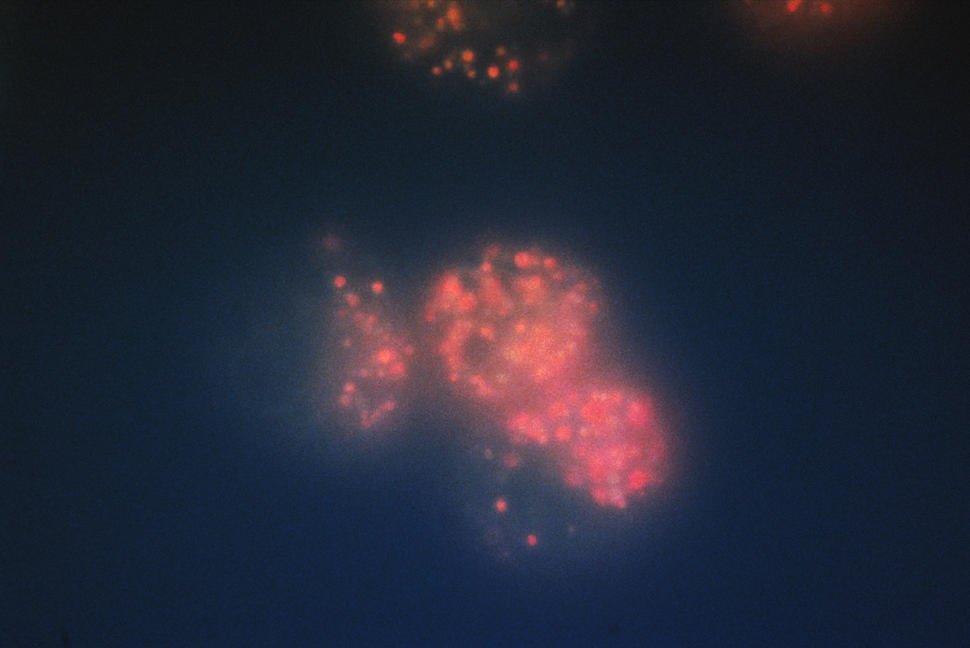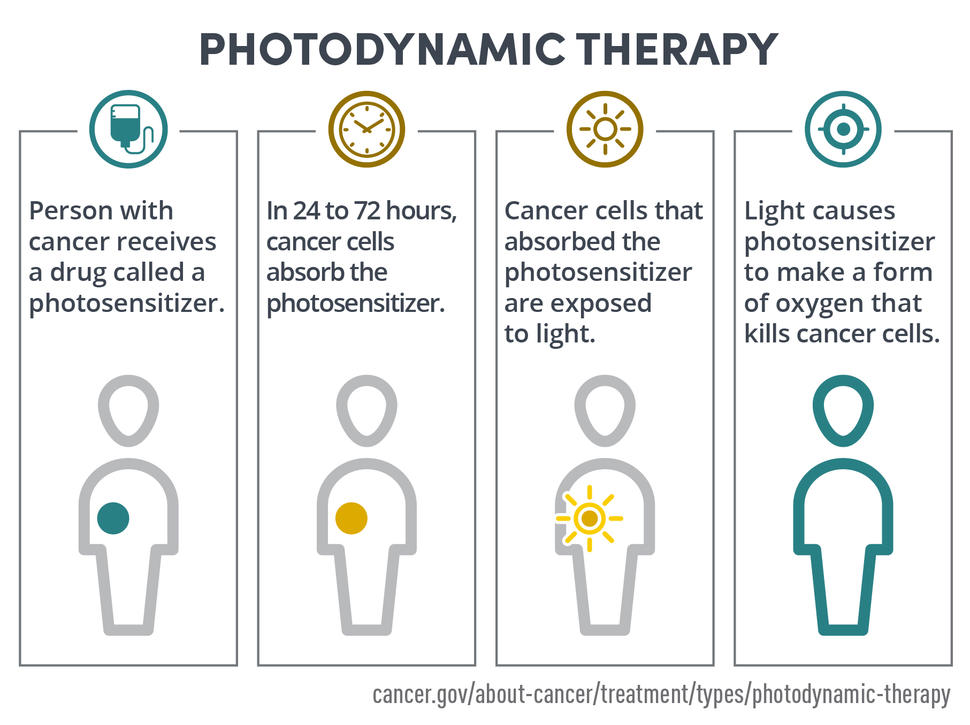What is photodynamic therapy?
Photodynamic therapy uses a drug that is activated by light, called a photosensitizer or photosensitizing agent, to kill cancer cells. The light can come from a laser or other source, such as LEDs. Photodynamic therapy is also called PDT.
Photodynamic therapy is most often used as a local treatment, which means it treats a specific part of the body.
Cancer and precancers treated with photodynamic therapy
The FDA has approved photodynamic therapy to treat:
- actinic keratosis
- advanced cutaneous T-cell lymphoma
- Barrett esophagus
- basal cell skin cancer
- esophageal (throat) cancer
- non-small cell lung cancer
- squamous cell skin cancer (Stage 0)
Photodynamic therapy is also used to relieve symptoms of some cancers, including:
- esophageal cancer when it blocks the throat
- non-small cell lung cancer when it blocks the airways
How photodynamic therapy treats cancer
When cells that have absorbed photosensitizers are exposed to a specific wavelength of light, the photosensitizer produces a form of oxygen, called an oxygen radical, that kills them.
Photodynamic therapy may also damage blood vessels in the tumor, which prevents it from receiving the blood it needs to keep growing. And, it may trigger the immune system to attack tumor cells, even in other areas of the body.
How photodynamic therapy is given
Photodynamic therapy is a two-step process. First, you will first receive a photosensitizer. The drug may be taken by mouth, spread on the skin, or given through an IV, depending on where the tumor is in the body. After 24 to 72 hours, most of the drug will have left normal cells but remain in cancer or precancer cells. Then your tumor will be exposed to the light source.
How the light is applied depends on where the tumor is. For skin tumors, the light is aimed right at the cancer. For tumors in the throat, airways, and lungs, your doctor will insert an endoscope down your throat. An endoscope is a thin, lighted tube that can help the doctor see inside the body. Once the endoscope is in place, the doctor threads a fiber optic cable that transmits light through it to reach the treatment areas.
One type of photodynamic therapy called extracorporeal photopheresis (ECP) is used to treat abnormal white blood cells that can cause skin symptoms in people with cutaneous T-cell lymphoma. In ECP, a machine collects your blood cells, treats them with a photosensitizer, exposes them to light, and then returns them to your body through a needle in a vein.
Most often, you will have photodynamic therapy as an outpatient, which means you go home after treatment and do not spend the night in the hospital. You may have photodynamic therapy by itself, or you may have it along with other cancer treatments.
Benefits of photodynamic therapy
Photodynamic therapy limits damage to healthy cells because the photosensitizers tend to build up in abnormal cells and the light is focused directly on them.
Photodynamic therapy does not cause scarring, which makes it good for people with skin cancers and precancers.
Drawbacks of photodynamic therapy
Photodynamic therapy can harm normal cells in the treatment area and cause side effects.
The light used in photodynamic therapy can’t pass through more than about 1/3-inch of tissue, or 1 centimeter. So, photodynamic therapy can only be used to treat tumors that are on or just under the skin or on the lining of internal organs or cavities.
Because the light can’t reach very far into large tumors, photodynamic therapy is less helpful in treating them.
Side effects of photodynamic therapy
Damage to normal cells is limited but photodynamic therapy can still cause burns, swelling, pain, and scarring in the treatment area. Other side effects may occur depending on the area that is treated, including:
- cough
- trouble swallowing
- stomach pain
- painful breathing
- shortness of breath
- skin problems, such as redness, stinging, swelling, or itching
A type of photosensitizer called porfimer sodium makes the skin and eyes sensitive to light for about 6 weeks. During this time, you should avoid direct sunlight and bright indoor light.
ECP can cause:
- brief periods of low blood pressure
- faster than normal heart rate
- anemia
- low blood platelet count
Side effects improve once treatment is over.
Where to go for photodynamic therapy
A small number of hospitals and cancer centers throughout the country have skilled doctors and the machines needed to perform photodynamic therapy. Talk with your doctor or contact hospitals and cancer centers in your area to find out if they are using this treatment.
Photodynamic therapy research
Researchers are looking for ways to expand photodynamic therapy to other cancers, including improving the equipment used and the delivery of the light.
Studies are underway to see if ECP may be used for other blood cancers and to help reduce rejection after stem cell transplants.
Researchers are also developing a new type of PDT called photoimmunotherapy, or PIT. In this treatment, a photosensitizer is combined with an immune protein that delivers the photosynthesizer to cancer cells. When light is applied, the photosynthesizer kills the cancer cells. This process also causes an immune response inside the tumor that can cause more cancer cells to die. Studies of PIT are going on with people with head and neck cancers. Other research is focused on finding photosensitizers that:
- are more powerful
- target cancer cells more precisely
- are triggered by light that can go through tissue to treat deep or large tumors
- cause fewer side effects
If you are interested in finding a clinical trial that uses photodynamic therapy, use the advanced clinical trials search form or contact NCI's Cancer Information Service.

